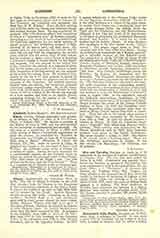

Aleppo, Archdiocese of (Armenian Rite), in Syria. The city of Aleppo is situated in the plain that stretches from the Orontes to the Euphrates in the northwestern extremity of the Syrian desert. It rises in the middle of an oasis on eight little hills, and is watered by the Kouik. Ancient Egyptian records mention this town. According to an Arab tradition, Abraham lived in it, and distributed some milk to every corner, whence the town’s name, Haleb. Seleucus Nicator (311-280 B.C.) gave it the name of Beroea (Berrhoe) by which it was known in early Christian times. Its present Semitic name dates from the Arab conquest in 630. It belonged to the Seljukids from 1090 to 1117; to the Ortokids from 1117 to 1183 (besieged by the Crusaders 1124); to the Ayoubites from 1183 to 1260 (Mongol Invasion); and to the Egyptian Sultans. In 1317 it passed definitively to the Ottoman Turks, except for the Egyptian occupation, 1833-39. Today it is the chief residence of a vilayet of the same name. In ancient times Aleppo was a commercial depot for the trade between India, the regions along the Tigris and the Euphrates, and the Mediterranean. Although it has long lost much of its importance, it still sends to Alexandria the products of Diarbekir, Mossoul, and Bagdad. It is noted for its fertile gardens and its healthy climate. A more disagreeable peculiarity is the ulcer known as the “Aleppo button”. The plague raged there in 1822. Its ramparts and forts have fallen into decay. Among the architectural monuments are a Roman aqueduct and a beautiful mosque of the Seljukid epoch. The population is about 127,000, of whom 97,450 are Mussulmans (Arabs, Turks, etc.), 19,200 Catholics (Greeks, United or Melchites, Syrians, Armenians, Maronites, Chaldeans, and Latins), 2,800 non-Catholic Christians (mostly Gregorian Armenians), and 7,800 Jews. Four Catholic archbishops govern the Melchites, the Syrians, the Armenians, and the Maronites. The Gregorian Armenians are administered by a Vartabet appointed by the Catholicos of Sis. The Orthodox Greeks are very rare in the town, but quite numerous in the surrounding country. They constitute a metropolitan diocese, which separated from the Patriarchate of Antioch in 1757, and was restored to it by the Patriarchate of Constantinople in August, 1888. In the eighteenth century the Orthodox metropolitan, Gerassimus (d. 1783, at Athos) was a stern enemy of the union with Rome. Aleppo remains the center of the French Catholic missions of Syria. In 1625 the Carmelites established themselves there; somewhat later they retired to Mount Cannel, where they built a monastery. (They had also in the Orient other stations.) In Aleppo they were succeeded by the Lazarists from 1785 to 1869. In 1873 the Jesuits founded a mission at Aleppo. In 1626 the Capuchins organized a “Custodia” from which were directed twelve missions. Their activity was interrupted by the French Revolution and in 1808 these Capuchin missions were given to the Italian Franciscans. The latter founded a college in 1859. The Sisters of St. Joseph direct a boarding-school. There are also Protestant missionaries in Aleppo. It has 260 schools: 115 Mussulman, 116 Christian, and 29 Israelite.
S. PETRIDES

